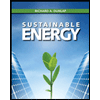
Concept explainers
Find the amount of coal (in kg) required for generating for each year.
Answer to Problem 17P
The amount of coal (in kg) required for generating electricity for each year are calculated and tabulated in Table 1.
Explanation of Solution
Given data:
Refer to problem 13-17 accompanying table in the textbook, the average efficiency of the power plants is 35%.
The heating value of the coal is
Formula used:
Formula to calculate the power plant efficiency is,
Rearrange the equation,
Convert kWh to MJ,
Formula to calculate the amount of coal required for generating one year is,
Calculation:
Find the energy input from the fuel in each year:
Substitute
Substitute
Substitute
Substitute
Substitute
Substitute
Substitute
Now convert all the values from kWh to MJ:
Substitute
Substitute
Substitute
Substitute
Substitute
Substitute
Substitute

Now find the amount of coal required in every year:
Substitute
Substitute
Substitute
Substitute
Substitute
Substitute
Substitute
Therefore, the energy input for all years for Coal, in kWh and MJ along with coal required to produce 35% of efficiency is shown in Table 1 (with approximately rounded values).
Table 1
| Energy Produced (10^9 kWh) | Energy(considering efficiency) 109 kWh | Energy (considering efficiency) 109 MJ | Amount of coal needed in kg |
| 1161.562 | 3318.748571 | 11947.49486 | 1.59E+12 |
| 1594.011 | 4554.317143 | 16395.54171 | 2.19E+12 |
| 1966.265 | 5617.9 | 20224.44 | 2.70E+12 |
| 2040.913 | 5831.18 | 20992.248 | 2.80E+12 |
| 2217.555 | 6335.871429 | 22809.13714 | 3.04E+12 |
| 2504.786 | 7156.531429 | 25763.51314 | 3.44E+12 |
| 3380.674 | 9569.068571 | 34772.64686 | 4.64E+12 |
Conclusion:
Hence, the amount of coal (in kg) required for generating electricity for each year has been calculated.
Want to see more full solutions like this?
Chapter 13 Solutions
Engineering Fundamentals
- YOUR TOP STADIA CROSSHAIR IN YOUR LEVEL YEILDS A Roo READING of 7.32 FT. YOUR BOTTOM STADIA CROSSHAIR READS 6.23 FT. How FAR AWAY FROM YOUR INSTRUMENT (LEVEL) IS YOUR STATION WHERE YOUR PHilly Roo IS LOCATED:arrow_forwardDetermin the internal angle given the following:arrow_forwardConvert the followingarrow_forward
- Slope Deflection for the fixed supported beam with a spring, k=2EI.arrow_forwardSITUATION. A uniform live load of 16 kN/m and a single concentrated live force of 34 kN are placed on the top beams. If the beams also support a uniform dead load of 3 kN/m, determinearrow_forwardComplete the profile leveling notes in Table 1. Show the arithmetic check and sample calculations of your work. Draw a neat sideview sketch showing the location of all stations and indicate on the sketch all of the numbers in your completed table.arrow_forward
- 3. A level loop was run starting at BM 20 and going clockwise around the loop shown below in Figure 2. The given known elevation of BM 20 is 1418.013 ft. When closing the level loop, BM 20 was found to have an elevation of 1417.890 ft. (a) Adjust the elevation of each station to correct for error. Show sample calculations of your work. (b) What is the accuracy ratio of the survey? BM 20 Elev. 1418.013 2.3 mi BM 20A Observed Elev. 1234.567 2.7 mi 1.6 mil 0.9 mi BM 20B Observed Elev. 1357.913 BM 20C Observed Elev. 1396.963arrow_forwardA W14 x 82 with 20 ft length column is part of a braced frame. The load and moments computed from service loads, and bending is about the x axis are (axial compressive dead load of 63 k; axial compressive live load of 76 k; upper dead moment of 32 ft-k; upper live moment of 56 ft-k; lower dead moment of 65 ft-k; lower live moment of 95 ft-k; the moments cause the member to bend in double curvature). Determine the lateral-torsional buckling modification factor C₁. ial live load ofarrow_forwardPROBLEM 1 Find the reaction at A and F. Compute for the force in members AB, BD, and DF. Use Method of Joints OR Method of Sections OR both. 3m B D C E 3m 100KN 3m 4marrow_forward
- I need detailed help solving this exercise from homework of Engineering Mathematics II.I do not really understand how to do, please do it step by step, not that long but clear. Thank you!P.S.: Please do not use AI, thanks!arrow_forwardI need detailed help solving this exercise from homework of Engineering Mathematics II.I do not really understand how to do, please do it step by step, not that long but clear. Thank you!P.S.: Please do not use AI, thanks!arrow_forwardI need detailed help solving this exercise from homework of Engineering Mathematics II.I do not really understand how to do, please do it step by step, not that long but clear. Thank you!P.S.: Please do not use AI, thanks!arrow_forward
 Engineering Fundamentals: An Introduction to Engi...Civil EngineeringISBN:9781305084766Author:Saeed MoaveniPublisher:Cengage Learning
Engineering Fundamentals: An Introduction to Engi...Civil EngineeringISBN:9781305084766Author:Saeed MoaveniPublisher:Cengage Learning
 Sustainable EnergyCivil EngineeringISBN:9781133108689Author:Richard A. DunlapPublisher:Cengage Learning
Sustainable EnergyCivil EngineeringISBN:9781133108689Author:Richard A. DunlapPublisher:Cengage Learning


